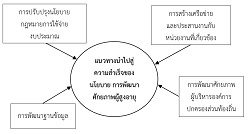EFFECTIVENESS OF POLICY IMPLEMENTATION ON ENHANCING ACTIVE AGEING IN NAKHONRATCHASIMA PROVINCE
DOI:
https://doi.org/10.14456/nrru-rdi.2020.78Keywords:
Enhancing active ageing, Effectiveness, Nakhon Ratchasima Province, Policy implementationAbstract
This study aimed to explore the effectiveness of policy implementation on enhancing active ageing in Nakhon Ratchasima Province, barriers, and construct a grounded theory of management strategy related to policy effectively, and evaluate quality of life (QOL) among older adults who received services in Nakhon Ratchasima Province. The research methodology was designed by using a mixed method design, concurrent embedded strategy was employed, a qualitative based on GT. Key informants were official providers of Local government, Provincial social development and human security, and Provincial public health. Moreover, there were older adults who receiving services. Data were collected in qualitative by using observation, in-depth interviews through semi structure. Quantitative instruments were questionnaires: effectiveness of policy management of official providers, older adults, and QOL assessment tool. Each item is rated on 0-4-point scale. Cronbach’s Alpha was used for reliability, those were 0.77, 0.79, and 0.90 respectively. Content analysis; Strauss and Corbin’s method was utilized. Quantitative; descriptive statistic and Pearson’s correlation were used. The results revealed that the effectiveness of managing policy was at a moderate level, also mean of evaluating by official provider and older adults; 97.98 (SD=26.51), 91.33 (SD=31.11) respectively. Four major themes emerged: 1) public policy development, law revision, and decentralization; 2) creating coordination and networks; 3) data based development; and 4) local government’s administrator development. The QOL was at high level (mean=80.05, SD=6.2), total score of 106. The effectiveness of public policy implementation was not relating to older adults’ QOL (r=-0.262, p>0.05).
References
Creswell, J. W. (2009). Research Design Qualitative, Quantitative, and Mixed Methods Approaches. Los Angeles : SAGE Publication.
Cylus, J., Figueras, J., & Normand, C. (2019). The economics of healthy and active ageing series, WILL POPULATION AGEING SPELL THE END OF THE WELFARE STATE: A review of evidence and policy options. Retrieved February 4, 2020, from https://silvereconomyforum.eu/wp-ontent/uploads/2019/07/PolicyBrief_AGEING_2019_web.pdf
Department of Older Persons, Ministry of Social Development and Human Security. (2018). Department of Older Persons Strategy-Year 2018-2038. Retrieved September 20, 2019, from http://www.dop.go.th/download/knowledge/th1539326153-138_0.pdf (In Thai)
Department of Provincial Administration. (2018). Civil registration statistical system. Retrieved September 20, 2019, from http://stat.dopa.go.th/stat/statnew/upstat_age_disp.php (In Thai)
Dye, T. (1972). Understanding Public Policy. Englewood Cliffs, N. J.: Prentice-Hall. pp. 2-10.
Hfocus. (2015). Insight health status. Retrieved November 20, 2019, from https://www.hfocus.org/content/2015/03/9583
Jantapo, A. & Kusoom, W. (2020). Lifestyle and Cultural Factors Related to Longevity Among Older Adults in the Northeast of Thailand. Journal of Transcultural Nursing, 1-8. doi: 10.1177/1043659620921225
Jitsuchon, S. (2015). Social inequity in Thailand: Trends, Policy and Implementation Strategy. Retrieved March 20, 2020, from https://tdri.or.th/wp-content/uploads/2017/06/Synthesis-Report-Year-2-Inclusive- Growth.pdf (In Thai)
Machluf, Y., Tal, O., Navon, A., & Chaiter, Y. (2017). From population databases to research and informed health decisions and policy. Front Public Health, (5), 1-11. Retrieved March 14, 2020, from https://www.ncbi.nlm.nih.gov/pmc/articles/PMC5613084/
Machón, M., Larrañaga, I., Dorronsoro, M., Vrotsou, K., & Vergar, I. (2017). Health-related quality of life and associated factors in functionally independent older people. BMC Geriatric, 17(19), 1-9. doi 10.1186/s12877-016-0410-3
Mahatnirankul, S. & Tuntipiwattanaskul, R. (2002). World Health Organization Quality of Life-Brief-Thai Version (WHOQOL-BREF-THAI). Retrieved January 13, 2020, from http://www.nursing.go.th/SidebarMenu/Indicators/[NSN_023]Tool.pdf (In Thai)
Monetary Policy Committee. (2018). The Challenges of Structural Thai Economy and Policy Coordination. Retrieved April 3, 2020, from https://www.bot.or.th/Thai/MonetaryPolicy/MonetPolicyComittee/MPR/BOX_MPR/BOX_MPR_22561_1.pdf (In Thai)
National Economic and Social Development Broad. (2018) The Twelfth National Economic and Social Development Plan Year 2018-2021. n.p. (In Thai)
Ohio University. (n.d.). 10 Traits of a Successful Public Administrator. Retrieved April 4, 2020, from https://onlinemasters.ohio.edu/blog/10-traits-of-a-successful-public-administrator/Park, J. H., & Park, Y. J. (2018). Systematic review on factors influencing the healthy ageing: A Korean perspective. J Aging Res Clin Practice, 7, 3-8. http://dx.doi.org/10.14283/jarcp.2018.2
Srivilas, E. (2015). Creating Network and Co-ordination. Retrieved March 20, 2020, from www.elifesara.com (In Thai)
Strauss, A., & Corbin, J. (1998). Basics of qualitative research: Techniques and procedures for developing grounded theory (2nd ed.). Thousand Oaks, CA : Sage.
Stufflebeam, D. L. & Zhang, G. (2017). The CIPP evaluation model: How to evaluate for improvement and accountability. New York : The Guilford press.
Thailand Development Research Institute. (2019). Reporting of TDRI. Retrieved April 4, 2020, from https://tdri.or.th (In Thai)
The Secretariat of The House of Representatives. (2017). Constitution of the Kingdom of Thailand (B.E. 2560 (2017)). Bangkok : Constitution Drafting Commission. (In Thai)
UK Essay. (2019). A database design and report on the impact of databases in the work place. Retrieved April 6, 2020, from https://www.ukessays.com/essays/information-systems/a-database-design-and-report-on-the-impact-of-databases-in-the-work-place.php
World Health Organization. (2002). Established the active ageing concept in 2002. Retrieved September 12, 2019, from https://www.who.int/ageing/publications/active_ageing/en/





